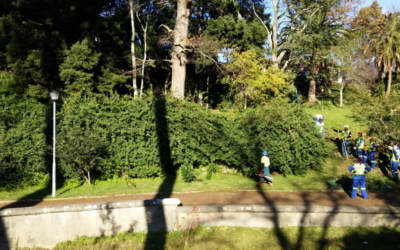There is an increasing sense among government officials, politicians, developers and public in general that Environmental Impact Assessments (EIAs) are not working as well as they could and are limited in their intended outcome at best. A variety of reasons are often given. The Friends of the Liesbeek cite a lack of commonsense and a failure to follow public participation processes as key elements of the growing frustration with EIAs. Recent experience of the Friends with the development of the double storey parking facility attached to the Rondebosch Village shopping centre is a case in point.
The Friends of the Liesbeek initially objected to a proposal to develop this car park situated adjacent to the Liesbeek River. Our primary objections were that the proposed construction would take place in a floodplain and that the quality of stormwater from the parking area would compromise the water quality of the river. These objections were based on principle since a parking area already existed and stormwater has flowed freely from this area into the river for years. Given the existing situation, the Friends realised that the developer would not need to undertake a full EIA study. Instead the proposal triggered a Basic Environmental Assessment which trims the exercise to a rapid assessment of the proposed development and most of all limits the participation of interested and affected parties, primarily the Friends of the Liesbeek. The Friends, who have built up a substantial knowledge and interest in the Liesbeek River for over 15 years, wanted to be involved in the development to ensure that the proposal contributed to the long term public good. Following the initial objection, the developer agreed to sign a formal Memorandum of Agreement which created a mechanism for sustained participation and co-operation between the developer and the Friends. Round No. 1: the objection is removed and the developer gets a green light to proceed with the submission of plans for the proposed development.
To the credit of the developer, a number of meetings were held with the Friends at various times during which ongoing plans were discussed. These included aspects of stormwater management, management during construction, landscaping, selection of vegetation to be planted and the general aesthetics of the building. Round No. 2: there is reasonable satisfaction on both sides.
But plans change. At the 11th hour the developer wishes to remove a pin oak tree situated near the edge of the river. This tree, a native of eastern North America, is about 30m high and is probably about 30 to 40 years old. Perhaps it was ‘the tree of the year’ and planted there by some well meaning members of the public during an Arbor Day celebration or perhaps it was planted as an act of benevolence by the then Cape Town City Council. The Friends have nothing against trees but this is one tree species that the river could do without. It sheds its foliage during winter thus adding to the biomass of the river which later collects as a decomposing mass of organic material in the Valkenburg Lake opposite Hartleyvale Stadium, Observatory. The developer had hoped to remove the tree so that the integrity of the cantilever structure of the upper storey would not be compromised. The tree sits on Council owned land. Round No. 3: City officials are adamant that the tree must remain.
You can almost hear the ceremonial response from North American tree groves that one of their number survived the chop. Humour aside, what happens next is interesting. If the tree is to remain then the design for the cantilever upper parking deck must change. City officials then agreed to let the developer build three support pillars on the pathway alongside the edge of river canal but the Friends are not consulted. Thus the idea of an open public walkway alongside the river is compromised. The outcome could have been different. Why weren’t the Friends consulted? Probably because they would have objected to the new proposal and would have insisted that the developer should forego the plan to construct the intended cantilever section. This would have resulted in a reduction in the number of parking bays by two or three, but would have left the pathway and edge of the river entirely free of any building structures. Now that there are three concrete pillars supporting the upper deck, a new precedent has been created: just how close can you build alongside a river? The limitation of an environmental impact assessment is exposed again because process has not been followed.
If you want to view one of the most expensive tree preservation projects in Rondebosch, have a look at the pin oak at the Rondebosch shopping centre. It cost the developer over R100 000 to change the design in order to preserve the tree. Where is the commonsense?


